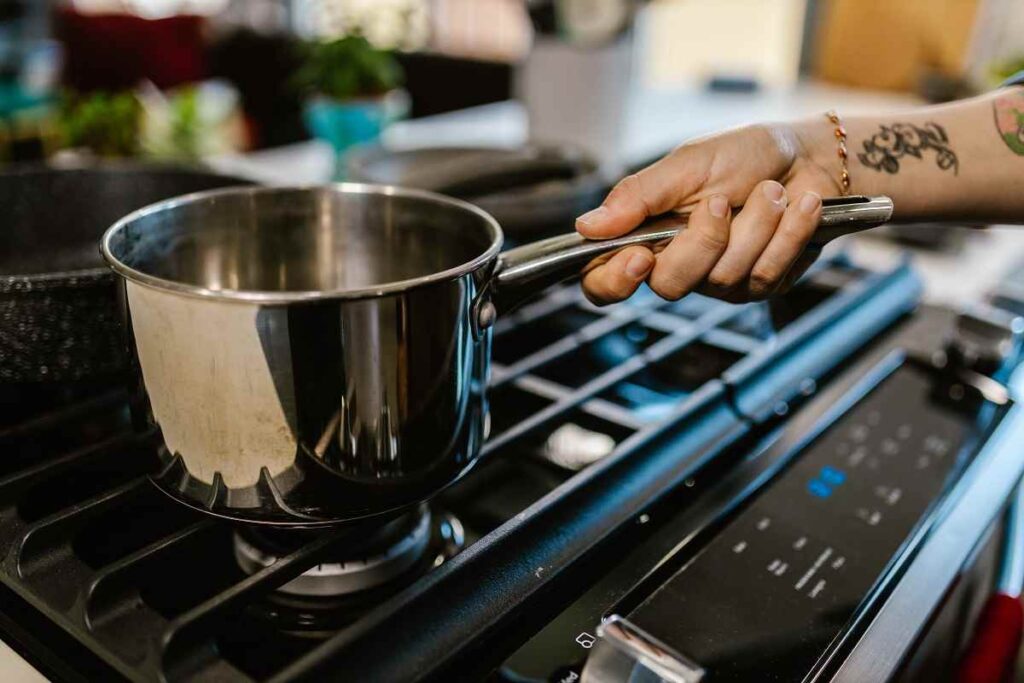
Burning food has remained a major concern in cooking for many years. This issue has often influenced people’s choices in the purchase of cookware.
10 ways to avoid burning food
To avoid burning food in a pot, follow these tips:
1. Use the right heat
Adjust the heat on your stove or cooktop to the appropriate level for the dish you’re preparing. Cooking on high heat for an extended period increases the risk of burning no matter what pot you use. Start with medium heat and adjust as needed.
2. Stir frequently
Regularly stir the contents of the pot to distribute the heat evenly. This prevents food from sticking to the bottom and burning. Use a wooden or silicone spoon that won’t scratch the pot’s surface.
3. Add enough liquid
When cooking dishes that require liquid, ensure that there’s enough in the pot. The liquid helps to maintain a moist environment and prevents burning. If the liquid evaporates too quickly, add more as needed.
4. Use a timer
Set a timer to remind yourself to check on the pot regularly. This is especially important when simmering or slow-cooking. It helps you avoid forgetting about the food and allows you to adjust the heat or add ingredients as necessary.
5. Reduce heat for delicate foods
Delicate foods, such as sauces or custards, are more prone to burning. Lower the heat and use a heat diffuser or double boiler setup to provide gentle and indirect heat.
6. Preheat properly
If you’re searing or sautéing, ensure that the pot is properly preheated before adding the ingredients. This helps to achieve even cooking and reduces the chances of sticking and burning.
7. Wash pots well before use
Residue from previous cooking sessions can contribute to burning. Clean your pot thoroughly after each use to prevent any leftover bits from affecting your current dish.
8. Avoid pots made of thin metallic materials
A pot with a thick, heavy bottom distributes heat more evenly and reduces the likelihood of hot spots that can lead to burning. Avoid thin and lightweight pots, especially for dishes that require longer cooking times.
9. Oil your pots
Dry and oilless cooking has been found to be more susceptible to burning. A good technique might be to add a small amount of oil to everything you are cooking. Doing this has been found to minimize the incidence of burning.
10. Stay attentive
Pay attention to the cooking process and avoid distractions. Burning can happen quickly, so it is essential to keep an eye on your pot while cooking.
Following these tips can reduce the risk of burning food in a pot and improve your cooking results.

Which type of pots burn food easily?
The basic truth is that any pot can burn food. You’d be surprised to learn that burning food is more about cooking techniques than the type of cookware used. However, while it is not accurate to say that specific types of pots inherently burn food, certain factors related to the pot’s construction and material can contribute to the likelihood of burning.
These types of pots have been found to allow food to get burnt easily:
a. Thin and lightweight pots:
Pots with thin and lightweight construction like aluminium pots tend to distribute heat unevenly, leading to hot spots that can burn food. Thin pots may also be more prone to warping or scorching.
b. Pots with poor heat conductivity:
Some materials have lower heat conductivity, meaning they take longer to heat up and distribute heat evenly. If the pot doesn’t conduct heat well, it can result in uneven cooking and increase the chances of burning.
c. Nonstick pots:
You will be surprised that this is on the list but the truth is that while nonstick pots have a coating that helps prevent food from sticking, they can be more susceptible to burning if the heat is too high. Moreso, overheating nonstick cookware can damage the coating, release toxic fumes, or even cause a fire hazard. You will find that nonstick pots will over time start to get burnt easily – this is due to the wearing away of the nonstick coating. It is best to buy nonstick pots with more quality coating, even if they may be more expensive.
d. Copper pots:
Copper pots are known for their excellent heat conductivity, but they require careful temperature control. Copper can heat up quickly, which may lead to burning if the heat is not properly managed.
Remember that proper cooking techniques, heat control, and attention during the cooking process are essential to prevent burning, regardless of the pot you’re using.



Great tips to avoid burning foods in pot.